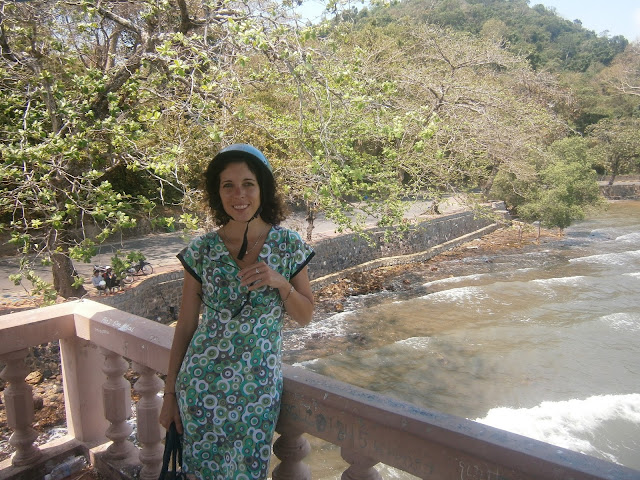The last three days of our trip we spent in the Cardamom Mountains. Bordering with Thailand to the West, this is one of Cambodia's wildest regions: enclosed by the sea to the South and by a mountain range to the North and North-East, it is said that the Khmer Rouge never managed to conquer it because of its difficult access.
 |
| Mountain landscape in Koh Kong |
On our first day we stayed a backpackers guesthouse where we were greeted by a tribe of bedbugs. The worst thing was that we actually knew from a fellow traveller that the place had recently had a bedbug problem. The owner said they had got everything disinfected, but, sadly, such visitors are the kind that won't go away that easily... and they feasted on Juanjo really badly.
The next day we arranged a two-day trekking excursion to experience the wilderness in all its might. And we sure did! As we were merrily sailing away towards the starting point of our trip, little did we know what was waiting for us on the other side.
 |
| A boat took us through the lush mangroves to the starting point of our trek |
Day One was just exhausting! And I have done some treks before. We went literally up the forest following the path of a ravine, climbing like mad goats over rocks, tree roots and beds of dry leaves. Me, of course, without proper footwear... All that at 35 degrees and a humidity level that made us sweat buckets.
 |
| Note for the future: Get some proper gear to hop on the mountains |
After about two hours we reached the top and we stopped at a clearing for lunch. Our Cambodian guides cooked delicious fresh fish with cabbage and lemongrass while we, the pale weaklings, indulged ourselves in the pool of a nearby waterfall... full of "pedicure" fish! Did I already mention that I love them fishes?
 |
| Juanjo, our fellow trekker Jens, and our Cambodian Sherpas |
After lunch we tackled the second half of the trek. Since we walked downhill most of the time, it wasn't as strenuous as the previous part. The way down was twice as tricky though, as we had to be extra careful not to slip off and break our skulls. Fun fact: Yin, one of our guides, who used to walk behind me, kept on holding up my backpack when I had to step down a slope. I guess he didn't like the idea of me reaching the bottom too fast.

Right before sunset we arrived at the farm where we were meant to spend the night. Well I think that was someone's spelling mistake, because that was certainly not a "farm", but a "barn". Our lodging was a mere stilted structure without walls equipped with a bunch of hammocks hanging from the roof. At the beginning I was glad to find a mattress, but now I think the hammock would have been a much better choice - it was rock hard, like sleeping right on the floor.
 |
| Our camping place |
The morning after I got the shits, maybe caused by the series of über-natural shocks I had the previous day. I was lucky enough to find an almost western toilet built a few meters from the barn. So, the Day-Two trek was simply a series of trips from hammock to bowl for me. Not a bad plan, considering that the others came back sooner than expected because it was too hot to be walking around.
On our last day in Koh Kong -back to civilisation- we rented a scooter to go to see the Tatay waterfall. Same as with the Kampot caves, some clever countryman who happened to live on the way decided to charge a one dollar entry fee. Now, we didn't regret it at all as you can judge from the pictures:
 |
| I think I'll take a shower... |
 |
| Free acupressure massage when you sit under the stream! |
And that was Koh Kong for us. We would have liked to have gone to the nearby beach after the waterfall, but we got a bad puncture on the way. So we had to lift the bike up into a tuk-tuk and take it back to the guesthouse... with the ensuing argument with the guy from the rental company about who should pay for the repairs!
Next stop: Battambang via Phnom Pehn. The country girl meets the capital! More to come in the next post...












































